Rit Dye review: This viral dye breathes new life into old clothes
Content is created by CNN Underscored’s team of editors who work independently from the CNN newsroom. When you buy through links on our site, CNN and its syndication partners may earn a commission. Learn more

This article is a part of CNN Underscored’s Earth Week, a weeklong focus on our planet and ways to celebrate and preserve it. We’ll be featuring tips on how to live more sustainably, products to help you spend more time in nature and exclusive deals all week, so check in every morning to see what’s new and be sure to subscribe to the CNN Underscored newsletter to see it all.
We can’t expect to love every article of clothing we buy forever — or for every item to remain free of blemishes and tears — but that doesn’t mean sending them to the landfill should be the default. Considering fashion’s role in the climate emergency, it’s crucial to extend the lives of pieces we own whenever possible. Mending is one way to do that; dyeing is another. And if you’ve spent enough time on sustainable living social media, you’ve probably come across some pretty creative “thrift flips” and DIY projects involving fabric dye; that’s exactly how I learned about Rit, a 100-plus-year-old brand of dyes for clothes and more.
While Rit has been around since long before social media, it’s enjoying a resurgence in popularity alongside the rise of visible mending, thrift-flipping and sustainable fashion. Head to the company’s website or social media, and you can easily fall down the rabbit hole of creative and inspiring projects that use Rit Dye to revitalize clothes, shoes, holiday decorations and even furniture. After seeing enough such projects pop up on my own feed, I knew I had to try Rit Dye myself.
Rit All-Purpose Liquid Dye
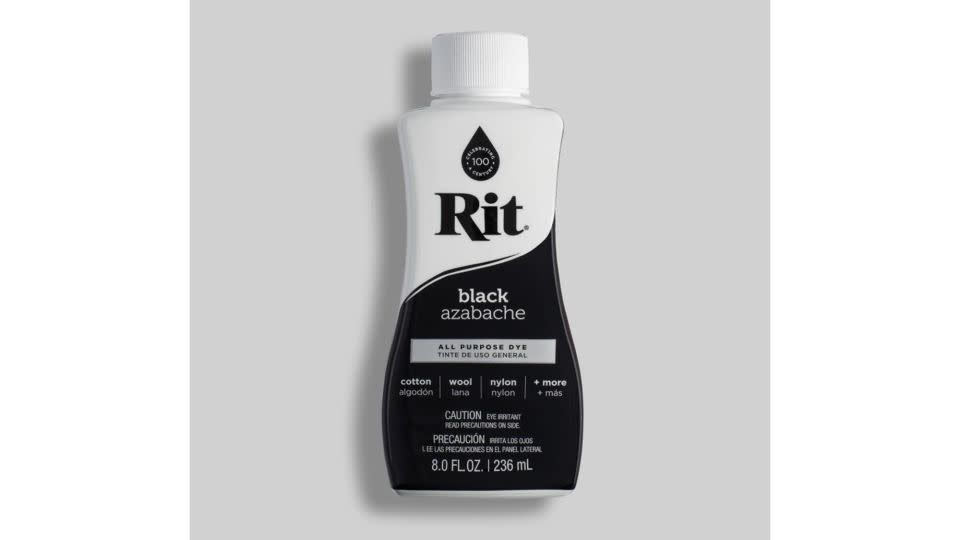
Rit’s All-Purpose Liquid Dye is perfect for anyone looking to revamp clothes made with natural fabrics like cotton, linen and silk, plus fabric shoes, unfinished wood and more. The color options are plenty, the process is simple and the results are impressive.
Rit DyeMore for Synthetics
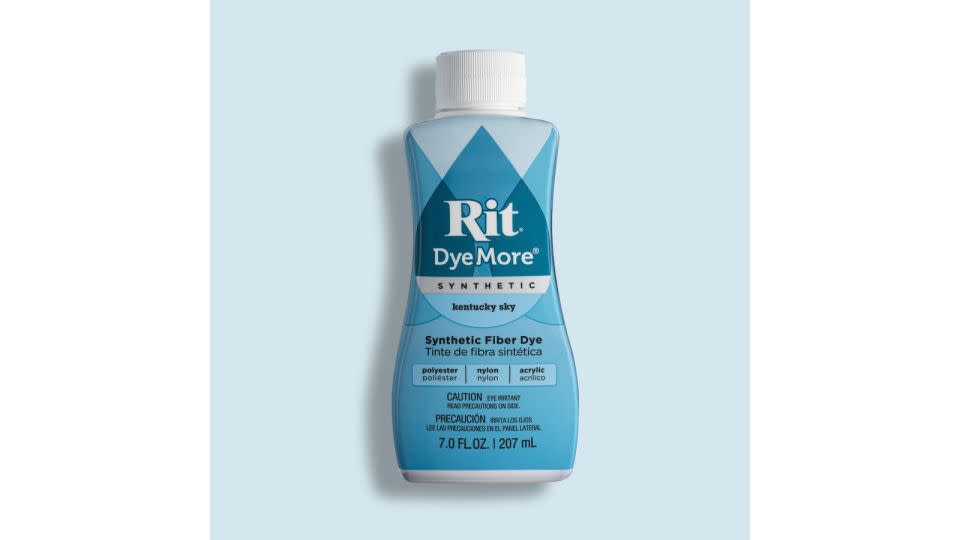
Rather than send your old or color-stained synthetic clothes to the landfill or donation bin, you can re-color them with Rit’s DyeMore for Synthetics, making them feel brand-new again for less than $10.
Rit Back to Black Dye Kit
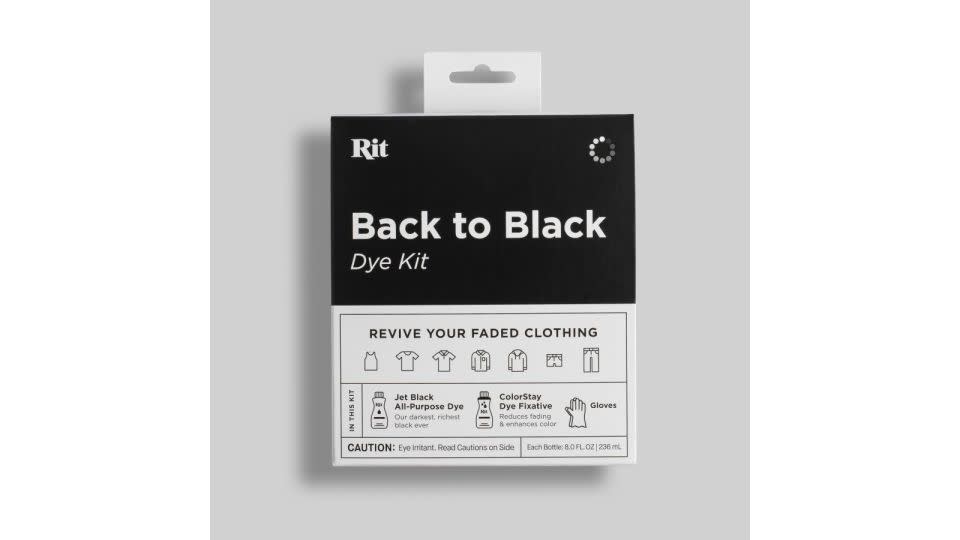
You don’t have to give up on your favorite black jeans or sweats just because they’re faded; Rit’s Back to Black Dye Kit makes it easy to refresh the jet-black shade with liquid dye, a color-stay solution and rubber gloves.
What is Rit Dye?
Rit’s two main products are the liquid All-Purpose Dye, a dye primarily for “natural” fabrics like cotton, linen and silk; and DyeMore for Synthetics, a liquid specially formulated for synthetic fabrics like polyester, acrylic and acetate (a necessary distinction because of how natural versus synthetic materials absorb and hold onto colors). The former also comes in a powder.
Per the website, the dyes are made with “a combination of various acid, disperse and direct dyes, along with sodium chloride,” and all have been deemed non-toxic by the Consumer Product Safety Commission (though they’re not food-grade — so you should pass on dyeing any toys your kids or pets might chew on). The dyes are also sewer- and septic-safe, so you can rinse and pour excess down your drain with peace of mind that they won’t destroy the plumbing.
How does Rit Dye work?
Though the processes vary slightly depending on which specific product you’re using, Rit works by using hot water to loosen the fibers of your fabric, allowing the dye to bond. If you’re going for a solid color on a natural fabric, you can achieve it with one of three main methods: sink or bucket, stovetop or washing machine.
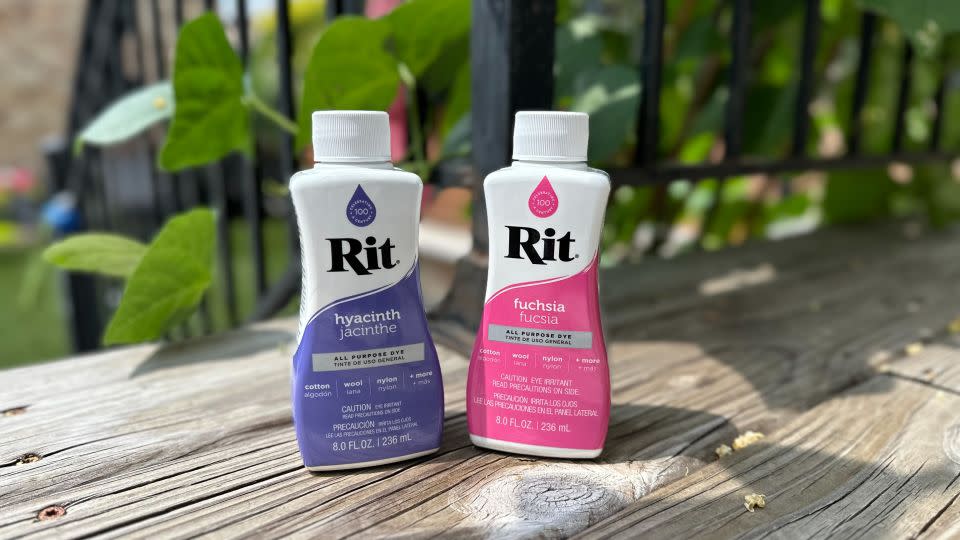
All three methods essentially involve immersing your item in a high-temperature dye bath for anywhere from 10 minutes to an hour, then rinsing in cool water to get rid of excess dye and washing in warm water to set the color. Because synthetic materials are more dependent on high heat to accept the dye, if you’re dyeing fabric that contains more than 35% synthetic materials, you’ll have to go the stovetop route to maintain the near-boiling water temperature.
What we liked about it
Giving clothes a second life
While Rit isn’t a perfectly eco-friendly product — the bottles are made from plastic, the dyes are made from (albeit “non-toxic”) chemicals and the website doesn’t offer any information on sustainable or ethical manufacturing — it still offers consumers an opportunity to meaningfully cut back on excess waste and new purchases. According to a Rit Dye blog post citing a Hult International Business School study, revitalizing four shirts with Rit’s products instead of buying four new ones can reduce your CO2 emissions by 74%. It goes hand-in-hand with the ethos behind mending — how can we look at our items through a different lens and give them new life before discarding them without a second thought?
While I haven’t measured the associated emissions, I can definitively say that I’ve used Rit Dye to bring plenty of garments back from the brink of the donation pile — or worse, landfill. The first product I tested was a white bathing suit top that I bought back in 2015 but stopped wearing a couple of years back because of accumulated sand and sunscreen discoloration. I was reluctant to get rid of it (most people don’t want to buy stained garments, so it probably would’ve wound up in the trash), so I was thrilled when I realized I could dye it another color and extend its life. Rit’s website says its dye won’t cover stains, but I tried anyway and found it actually worked — or at least, masked the blemishes enough to make them unnoticeable.
After my first successful dye project, I went on to revive plenty more pieces. Instead of donating a white blouse that I never wore and then buying a more colorful one in its place, I was able to transform the former into the latter. I also revived faded black secondhand jeans and a button-up shirt, a tank with a bizarre, faint laundry stain, a white linen coverup, a black-and-white striped dress and, in my first non-clothing Rit attempt, a mini wooden chest of drawers.
Ease of use
Rit Dye offers an easy and relatively turnkey method for giving your clothes new color and life. The dye bottles themselves include basic written instructions, with even more detailed guides on the Rit website. There, you can find in-depth tutorials — with photos and sometimes videos — of nearly every technique and use of Rit products. It can seem overwhelming at first, but the step-by-step instructions are clear and easy to follow. Depending on your setup and project specifics, you can definitely get some dyeing done in the span of an hour or two (maybe even less, if you’re efficient).
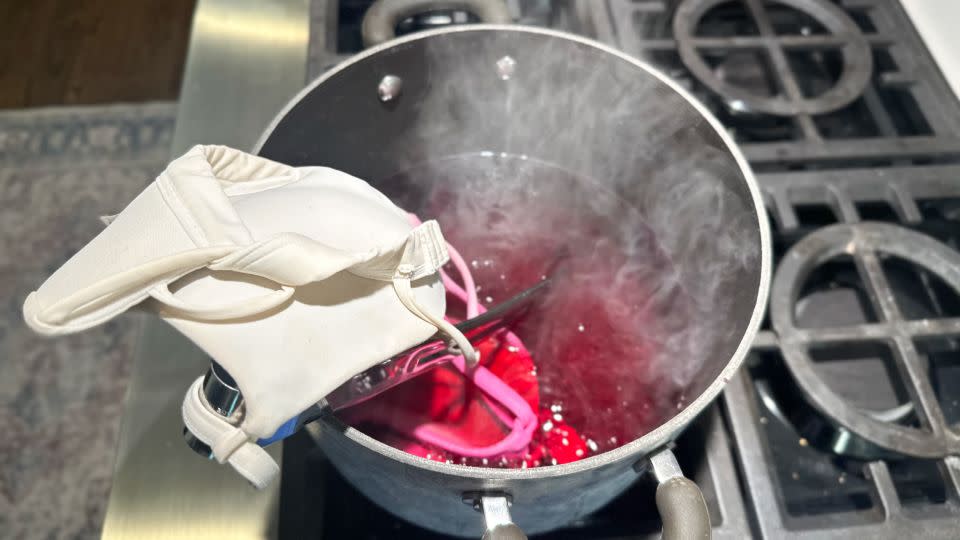
I tested both the liquid and powder dyes; both were easy enough to use, though I generally preferred the former over the latter. The liquid is pre-mixed, but the powder has to be dissolved in hot water before going into the main dye bath, adding an extra step. If you’re not planning to use your dye right away and are tight on storage space, though, the powder comes in nice, small boxes that take up significantly less space than the bottles.
Wide variety of colors
Rit offers a vast selection of dye colors that take you well beyond the class ROYGBIV rainbow shades, and if you still can’t find quite what you’re looking for, you can use the incredibly extensive color formula guide and color mixing instructions to create it yourself. So far, I’ve experimented with hyacinth, fuschia and tangerine all-purpose liquid dye, fuschia, golden yellow, tangerine and teal all-purpose powder dye, peacock green DyeMore for Synthetics liquid dye and the Back to Black Kit and have loved all of the outcomes.
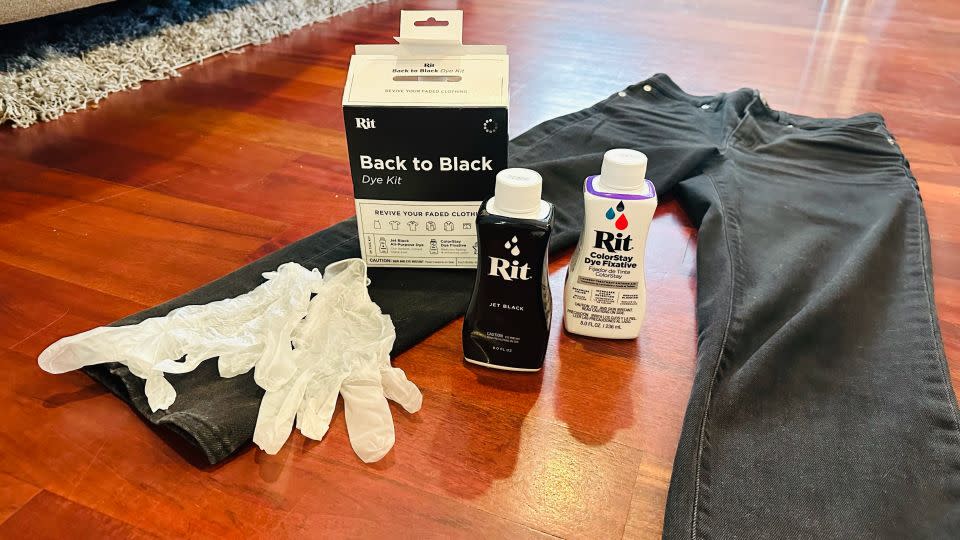
By and large, the end results reflected the color indicated on the packaging pretty closely, though the depth of color depends on how concentrated your dye bath is, how long you leave the material in it and the material itself — for example, the peacock green synthetic dye resulted in a very different shade on my white polyester blouse than my white-and-black striped rayon dress — but that’s part of the fun of it, in my opinion, because it expands the possibilities of what you can do with a single product.
I used the Back to Black kit, which includes jet black All-Purpose Dye, ColorStay Dye Fixative and a pair of rubber gloves, on two faded black secondhand items: jeans and a button-down shirt. The process is the same as with the other colors — plus the added step of a dye fixative bath before rinsing — and I’m pleased to say after many wears of each, the deep black color remains. You can buy black dye and the color fixative separately (they’re $5 each, while the kit is $11
Endless creative possibilities
In addition to dyeing garments solid colors, you can get creative with techniques like tie-dye, shibori, ombre, marbling and more. When it came to my first project — the aforementioned white bikini top — I was too excited and indecisive to choose one technique, so I opted for two. I started with Rit’s shaving cream method to marble-dye one half, and it couldn’t have been easier (it was also the fastest of all the techniques I tested because you only have to leave your fabric on the dye for a minute or two). For the other side of the bikini, I went with the classic stovetop method; it was a bit tough to keep half of the top in the pot and half out, so the resulting solid color is slightly uneven, but it works.
I also tried ice dyeing with Rit’s powder dye, attempting both techniques featured on Rit’s website. I used the scrunch method on a thrifted white linen cover-up that I was always hesitant to wear because didn’t trust myself to keep it clean at the beach, and it worked like a charm. Once I dyed it so that the white portions were minimal, I couldn’t wait to wear it — and, in fact, broke it out on my next beach visit.
I’ll need to give the incline method another go — it was tougher to keep the colors separated than it looked in the video tutorial, and I didn’t love the final result (something I realized only after I set the dye with a rinse and wash). Silver lining: It gave me an opportunity to try Rit’s Color Remover, a chlorine-free solution meant to remove dye and other stains from whites, or existing color from natural fabrics before you re-dye them. The instructions recommend using Color Remover in a well-ventilated area, so I opted for the bucket method on my back deck; by the end of the approximately 20-minute bath, most — but not all — of the dye was gone from my tank. My best guess as to why the solution didn’t remove everything is that, per the instructions, the sink or bucket method is less reliable than the stovetop method; regardless, I’m actually happy with the remaining faint pattern on my shirt, so it was a win for me.
Not just for clothes
Rit Dye can be used for more than what’s in your closet (or fabrics in general); you can also dye countless other materials, including plastic, paper, feathers, cork, clay and (unfinished) wood. That knowledge came in handy when I unexpectedly received a miniature wooden chest of drawers in the mail as part of a gift packaging. I realized I could use the drawers to store craft supplies, but the wood was unfinished and pretty uninteresting. I mixed some orange all-purpose dye with hot water and used the brush method to paint a color-blocked design.
Unlike other paints, Rit Dye is transparent enough that you can still see the wood grain through the color, resulting in a nice, “natural” look. The next non-clothing item on my list: shoes. I’m excited to revive some white canvas slip-ons that have seen better days and to dye my ancient gray Ugg boots black.
What we didn’t like about it
Lack of sustainability information
While Rit Dye is a fantastic tool for revitalizing old items to keep them out of landfills — and to keep you from buying more unnecessarily — the only sustainability and ethics information on its website focuses on that aspect. There’s no transparency about the manufacturing process, the packaging (the liquid dye is in plastic bottles) or the company’s labor practices. While we know the Consumer Product Safety Commission classifies the dyes as non-toxic and, according to product safety sheets, they’re not considered to be hazardous to health “at their given concentrations,” the ecological information on those safety sheets simply says “long-term ecological studies have not been conducted for this product.” (It’s also worth noting that while the dyes aren’t considered health hazards, that may not be the case for all of Rit’s dyeing aids and laundry additives. The ColorStay Dye Fixative, for example, can cause “mild skin irritation” and “eye irritation,” though I didn’t experience either while using it — so if you’re concerned, be sure to check out the info before you use a product.)
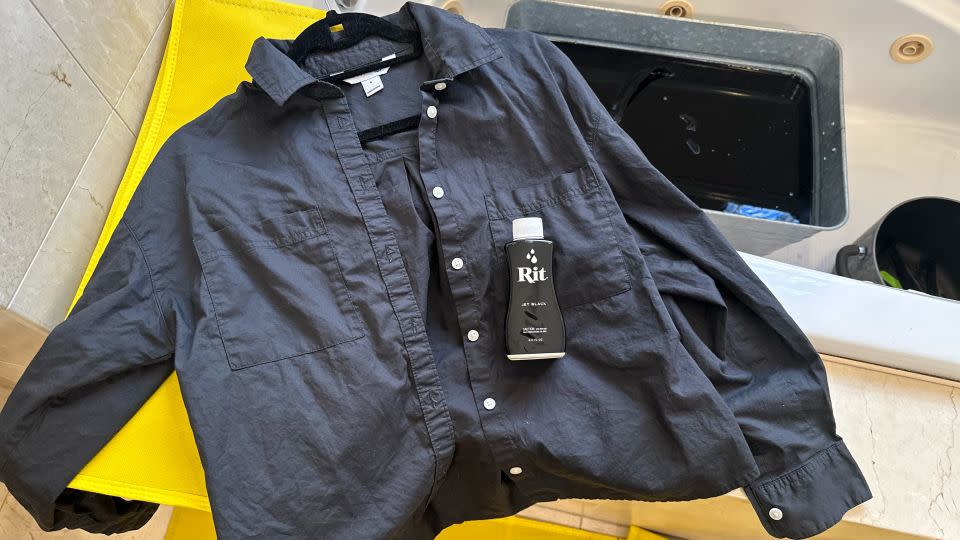
That said, this is one of those things that may be best viewed through an “imperfect environmentalist” lens. Sure, you can DIY dyes from fruits and veggies, but plant dyes tend not to adhere well to synthetic fabrics, and if you’re not up for the task (or are concerned about fading), using something like Rit still seems like a more earth-friendly option than disposing and re-buying — especially if what you re-buy is dyed with chemicals, anyway.
Additional tools needed
When I prepared for my first dye project, I quickly realized I would need to gather quite a few supplies before I could do anything. At a minimum, if you’re doing the stovetop or bucket method, you’ll need a container large enough for the dye bath and whatever you’re putting in it, a measuring cup, metal tongs or a large metal spoon and rubber gloves. Rit warns against dyeing in a container that you also use for food (if you can’t avoid it, the website suggests cleaning the container with chlorine bleach or a powdered cleanser after dyeing), so I ruled out all of my existing pots and cooking utensils. While you can dye in a stainless steel sink (but not porcelain or fiberglass), I was hesitant to do so, considering my sink also comes into regular contact with my cooking and eating supplies. I was loathe to spend too much money or create more waste on a whole new set of dyeing supplies, especially before even trying this out, but I was able to find a stovetop pot, a large galvanized metal bucket and the additional tools at my local thrift stores (I already had a few pairs of sturdy rubber gloves for cleaning, so I designated one specifically for dyeing).

If you’re keen to try some of the more creative techniques, you might need even more. The ice dyeing, for example, required a flat cooling rack (again, it’s best not to use one that’s in your actual kitchen rotation), while the marble dyeing required a squeeze bottle or medicine dropper, stir stick, spatula and sheet pan.
Rit also recommends using the ColorStay Dye Fixative to lock in the color on anything containing cotton, linen, silk, wool, ramie or rayon. A single $5 bottle is enough for approximately four adult t-shirts, if you follow Rit’s recommended proportions, so it can add up if you plan to do extensive dyeing.
The bottom line
If you have clothes, shoes or decor that have been gathering dust — whether because of stains or your evolving personal taste — but are hesitant to get rid of them, give Rit Dye a go. Even those who don’t consider themselves “crafty” can succeed in this DIY project, particularly with the help of Rit’s extensive “how-to” guides. The myriad, vibrant color options and suggested dyeing techniques make it easy to transform what you already own into something that feels new, customized and exciting, while cutting back on your household waste.
Note: The prices above reflect the retailers' listed price at the time of publication.
For more CNN news and newsletters create an account at CNN.com

